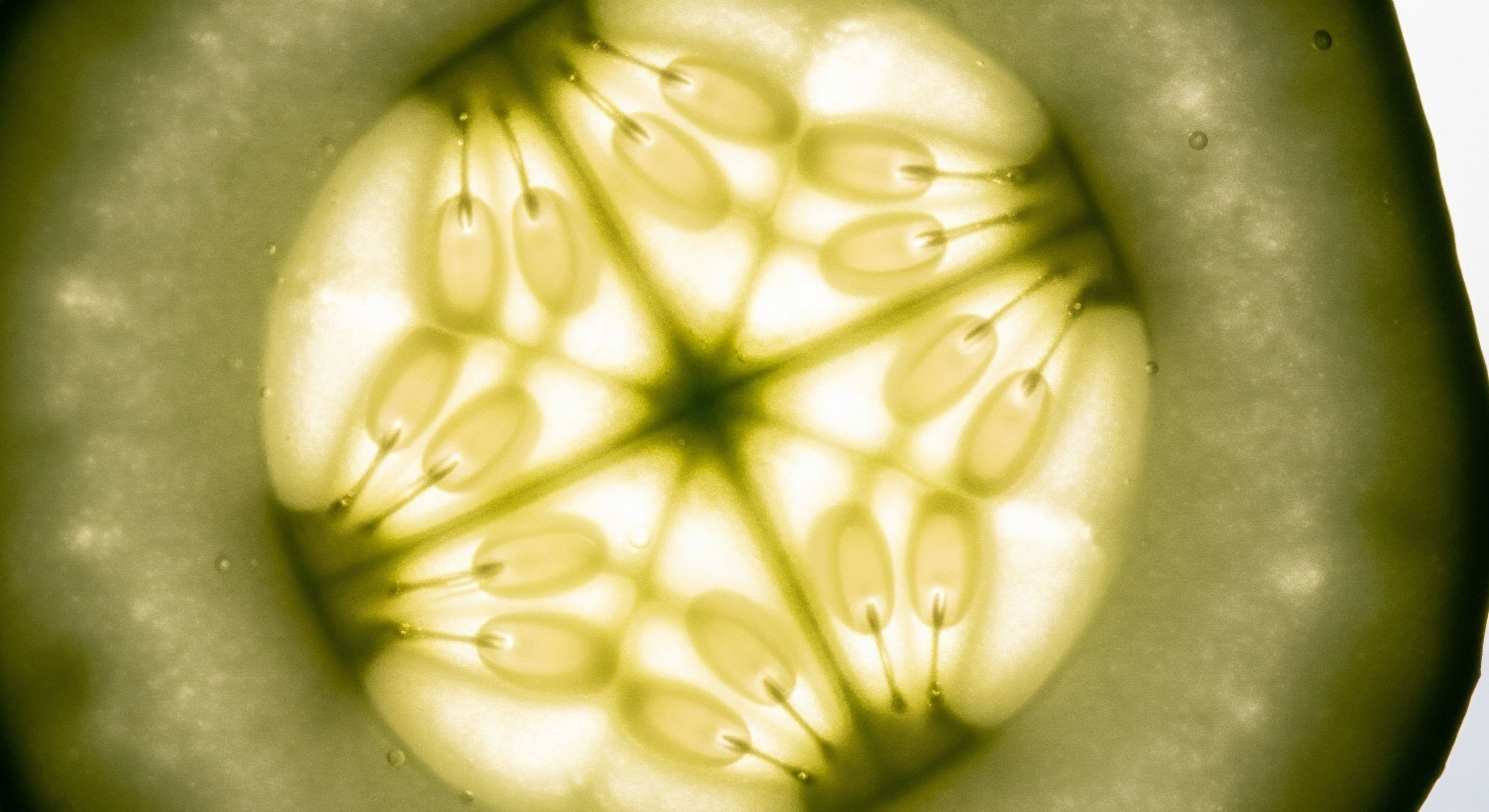


Fundamentals
Feeling a shift in your body’s rhythm, a quiet disquiet that whispers of changes within, can be a profoundly personal experience. Perhaps you have navigated the path of testosterone replacement therapy, finding a renewed sense of vitality, only to consider a different direction now. The idea of discontinuing exogenous testosterone and encouraging your body to resume its own natural production often brings with it a mix of hope and apprehension.
You might wonder, with valid concern, about the journey ahead for your body’s internal systems, particularly the delicate balance of your endocrine function. This contemplation is not merely about a medical decision; it is about reconnecting with your own biological blueprint, seeking to recalibrate your internal messaging system to its optimal state.
Understanding the body’s intrinsic capacity for self-regulation begins with recognizing the central command center for male reproductive health ∞ the Hypothalamic-Pituitary-Gonadal (HPG) axis. This intricate communication network operates like a sophisticated internal thermostat, constantly monitoring and adjusting hormone levels. The hypothalamus, a region in the brain, initiates the process by releasing gonadotropin-releasing hormone (GnRH). This chemical signal travels to the pituitary gland, a small but mighty organ situated at the base of the brain.
Upon receiving the GnRH signal, the pituitary gland responds by secreting two crucial hormones ∞ luteinizing hormone (LH) and follicle-stimulating hormone (FSH). LH then travels through the bloodstream to the testes, stimulating the Leydig cells to produce testosterone. Simultaneously, FSH acts on the Sertoli cells within the testes, which are vital for supporting sperm development, a process known as spermatogenesis. This coordinated action ensures both testosterone production and fertility.
The body’s internal hormone regulation is a complex communication network, similar to a finely tuned thermostat.
When exogenous testosterone is introduced, as in testosterone replacement therapy, the body’s HPG axis perceives an abundance of circulating testosterone. This triggers a negative feedback loop, signaling to the hypothalamus and pituitary gland that less internal production is needed. Consequently, the release of GnRH, LH, and FSH diminishes significantly.
This suppression leads to a reduction in the testes’ natural function, causing them to shrink and their inherent testosterone production to slow or halt. The goal of post-TRT testicular restoration protocols is to gently reawaken this suppressed axis, encouraging the testes to resume their natural activity.


The Body’s Adaptive Response to External Hormones
The human body possesses remarkable adaptive capabilities, constantly striving for equilibrium. When external testosterone is supplied, the Leydig cells in the testes, responsible for producing testosterone, receive a signal to reduce their activity. This physiological adaptation is a direct consequence of the negative feedback mechanism inherent to the HPG axis.
The testes, no longer needing to work as hard, decrease in size and function, a phenomenon known as testicular atrophy. This is a common and expected outcome of long-term exogenous testosterone administration.
Restoring testicular function post-TRT involves reversing this adaptive suppression. It requires a strategic approach to stimulate the HPG axis back into action, prompting the testes to regain their size and capacity for hormone synthesis and sperm production. The individual’s unique biological makeup, including genetic predispositions and overall metabolic health, plays a significant role in how effectively and quickly this restoration can occur. Each person’s system responds with its own timing and degree of responsiveness.


Why Does Individual Biology Matter for Restoration?
The journey toward restoring natural testicular function after testosterone replacement therapy is not a uniform experience. While the underlying biological principles apply to everyone, the speed and completeness of recovery vary considerably from one person to another. This variability stems from a multitude of individual factors that influence the responsiveness of the HPG axis and the testicular cells themselves.
- Duration of Testosterone Replacement Therapy ∞ The length of time an individual has been on exogenous testosterone can influence the degree of HPG axis suppression. Longer periods of suppression may require more sustained efforts for restoration.
- Dosage of Testosterone ∞ Higher doses of exogenous testosterone typically lead to more pronounced suppression of the HPG axis, potentially making restoration a more gradual process.
- Age of the Individual ∞ Younger individuals often exhibit a more robust and responsive HPG axis, which can translate to quicker and more complete restoration outcomes compared to older individuals whose natural endocrine function may already be declining.
- Pre-existing Testicular Health ∞ Any underlying conditions affecting testicular function prior to TRT, such as primary hypogonadism or varicocele, can influence the baseline capacity for natural testosterone production and, consequently, the restoration potential.
- Overall Metabolic and Endocrine Health ∞ The body’s broader metabolic state, including factors like insulin sensitivity, thyroid function, and body composition, can significantly impact hormonal signaling and the responsiveness of the HPG axis.



Intermediate
When considering the path to encouraging the body’s own testosterone production after a period of exogenous support, a precise and thoughtful approach becomes paramount. The aim is to gently nudge the HPG axis back into its natural rhythm, stimulating the testes to resume their vital functions. This process often involves a carefully selected combination of pharmaceutical agents, each designed to address specific points within the endocrine feedback loop. The goal is to provide the right signals to the body, encouraging it to restart its internal manufacturing process for testosterone and sperm.


Targeted Protocols for Testicular Reawakening
The post-TRT or fertility-stimulating protocol for men typically involves a combination of agents that work synergistically to reactivate the HPG axis. These agents act on different parts of the endocrine system, collectively working to overcome the suppression induced by prior testosterone administration. The selection and dosing of these medications are highly individualized, tailored to the patient’s specific needs, baseline hormonal status, and restoration goals.
One primary agent in this protocol is Gonadorelin. This synthetic peptide mimics the action of natural gonadotropin-releasing hormone (GnRH), which is produced by the hypothalamus. By administering Gonadorelin, typically through subcutaneous injections twice weekly, we provide a pulsatile signal to the pituitary gland. This pulsatile stimulation is crucial, as continuous GnRH exposure can paradoxically lead to pituitary desensitization.
The precise timing and frequency of Gonadorelin administration are designed to mimic the body’s natural release patterns, thereby stimulating the pituitary to release LH and FSH. This direct stimulation helps to overcome the hypothalamic suppression that occurs during TRT, effectively restarting the upper echelon of the HPG axis.
Post-TRT restoration protocols use specific agents to reactivate the body’s natural hormone production system.
Another cornerstone of these protocols involves selective estrogen receptor modulators (SERMs), such as Tamoxifen and Clomid (clomiphene citrate). These medications operate by blocking estrogen’s negative feedback on the hypothalamus and pituitary. Estrogen, derived from the conversion of testosterone, signals to the brain that sufficient sex hormones are present, thus dampening LH and FSH release. By blocking estrogen receptors in the brain, Tamoxifen and Clomid effectively trick the hypothalamus and pituitary into perceiving lower estrogen levels.
This perception prompts an increased release of GnRH, and subsequently, higher levels of LH and FSH from the pituitary. The elevated LH and FSH then directly stimulate the testes to produce more testosterone and support spermatogenesis. Clomid, in particular, is widely used for its efficacy in stimulating endogenous testosterone production and improving sperm parameters.


Managing Estrogen during Restoration
As the testes begin to produce more testosterone during the restoration process, there is a natural increase in the conversion of testosterone to estrogen via the aromatase enzyme. While some estrogen is vital for male health, excessively high levels can counteract the restoration efforts by re-establishing negative feedback on the HPG axis, or lead to undesirable side effects such as gynecomastia or water retention. To mitigate this, an aromatase inhibitor like Anastrozole may be included in the protocol. Anastrozole works by directly blocking the aromatase enzyme, thereby reducing the conversion of testosterone to estrogen.
This helps maintain a healthy testosterone-to-estrogen ratio, supporting the overall effectiveness of the restoration protocol and minimizing potential adverse effects. The dosage of Anastrozole is carefully titrated based on individual estrogen levels, as monitored through regular blood work.
The interplay of these agents creates a comprehensive strategy for testicular restoration. Gonadorelin provides the direct signal to the pituitary, while Tamoxifen and Clomid remove the brakes on the HPG axis, allowing for increased LH and FSH release. Anastrozole, when needed, ensures that rising testosterone levels do not lead to excessive estrogen, which could hinder progress. This multi-pronged approach respects the complexity of the endocrine system, aiming to restore its natural balance rather than simply overriding it.


Comparing Restoration Agents
Each medication within a post-TRT restoration protocol serves a distinct purpose, contributing to the overall goal of re-establishing natural testicular function. Understanding their individual roles helps appreciate the comprehensive nature of these treatment plans.
| Agent | Primary Mechanism of Action | Target in HPG Axis | Typical Administration |
|---|---|---|---|
| Gonadorelin | Mimics GnRH, stimulating pulsatile LH/FSH release | Hypothalamus/Pituitary | Subcutaneous injection, 2x/week |
| Tamoxifen | Blocks estrogen receptors in hypothalamus/pituitary, reducing negative feedback | Hypothalamus/Pituitary | Oral tablet, often daily |
| Clomid | Blocks estrogen receptors in hypothalamus/pituitary, reducing negative feedback | Hypothalamus/Pituitary | Oral tablet, often daily or every other day |
| Anastrozole | Inhibits aromatase enzyme, reducing testosterone-to-estrogen conversion | Peripheral tissues (e.g. fat, liver) | Oral tablet, 2x/week (as needed) |
The precise combination and dosage of these agents are determined by the individual’s unique physiological response, which is closely monitored through regular blood tests measuring testosterone, LH, FSH, and estrogen levels. This personalized adjustment ensures the protocol is optimally aligned with the body’s progress toward restoration.
Academic
The intricate dance of hormonal regulation, particularly within the male endocrine system, presents a fascinating challenge when attempting to restore endogenous function after exogenous suppression. The success of post-TRT testicular restoration is not merely a matter of applying a standard protocol; it is deeply influenced by a constellation of individual biological variables that dictate the responsiveness of the HPG axis and the testicular Leydig and Sertoli cells. A truly comprehensive approach requires delving into the molecular and cellular mechanisms that underpin these individual differences.


Genetic Predisposition and Receptor Sensitivity
At the core of individual variability lies genetic predisposition. Polymorphisms in genes encoding hormone receptors, enzymes, and signaling molecules can significantly impact how an individual’s endocrine system responds to therapeutic interventions. For instance, variations in the androgen receptor (AR) gene can influence the sensitivity of target tissues, including the hypothalamus and pituitary, to circulating testosterone and its metabolites.
A less sensitive AR might require higher levels of LH and FSH stimulation to elicit a robust testicular response, potentially prolonging the restoration period. Similarly, genetic variations in the aromatase enzyme (CYP19A1) can affect the rate at which testosterone converts to estrogen, influencing the need for aromatase inhibitors and the overall hormonal milieu during recovery.
The pituitary gland’s capacity to produce and release LH and FSH in response to GnRH is also subject to individual variation. Studies have indicated that the duration and degree of HPG axis suppression during TRT can lead to a desensitization or downregulation of GnRH receptors on pituitary gonadotrophs. The speed at which these receptors regain their sensitivity and density post-TRT is a critical determinant of restoration success. This cellular recalibration is not uniform across individuals, reflecting differences in cellular signaling pathways and protein synthesis rates.
Individual genetic makeup and cellular receptor sensitivity play a significant role in how the body responds to hormonal restoration efforts.


Metabolic Interplay and Endocrine Crosstalk
The endocrine system does not operate in isolation; it is deeply interconnected with metabolic health. Conditions such as insulin resistance, obesity, and chronic inflammation can profoundly impact hormonal signaling and testicular function. Adipose tissue, particularly visceral fat, is a significant site for aromatase activity, converting testosterone into estrogen. Higher body fat percentages can therefore lead to elevated estrogen levels, which exert a stronger negative feedback on the HPG axis, making restoration more challenging.
Chronic inflammation, often associated with metabolic dysfunction, can also suppress GnRH pulsatility and directly impair Leydig cell function. Inflammatory cytokines can interfere with the signaling pathways necessary for testosterone synthesis. Addressing underlying metabolic imbalances through lifestyle interventions, such as dietary modifications and regular physical activity, can therefore be a crucial adjunct to pharmacological restoration protocols. This holistic perspective acknowledges that optimizing the internal environment supports the body’s inherent capacity for healing and rebalancing.


Does Prior Health Status Influence Restoration Speed?
The pre-TRT health status of the testes themselves is a major predictor of restoration outcomes. Men with pre-existing conditions causing primary hypogonadism, where the testes themselves are unable to produce sufficient testosterone despite adequate LH/FSH stimulation, will naturally face greater challenges in restoration. Conditions such as Klinefelter syndrome, cryptorchidism, or prior testicular trauma can result in irreversible damage to Leydig and Sertoli cells, limiting their capacity for recovery. In contrast, men with secondary hypogonadism, where the issue lies with the hypothalamus or pituitary, often exhibit a more robust response to HPG axis stimulation, as their testes retain their functional capacity.
The duration of testosterone suppression also plays a role. While the HPG axis can be remarkably resilient, prolonged periods of profound suppression may lead to more persistent changes in testicular cellular architecture and function. This can include a reduction in Leydig cell numbers or impaired enzymatic activity within these cells. The concept of “testicular memory” suggests that the longer the suppression, the more significant the cellular adaptations, potentially requiring more intensive or prolonged stimulation to reverse.
Consider the impact of age on testicular restoration. As men age, there is a natural decline in Leydig cell function and a reduction in GnRH pulsatility, contributing to age-related hypogonadism. This age-related decline means that an older individual’s HPG axis may be less responsive to stimulatory agents compared to a younger person. The cellular machinery involved in hormone synthesis and spermatogenesis may simply be less efficient, making the restoration journey longer and potentially less complete.
The table below illustrates some key factors and their potential impact on the restoration timeline.
| Individual Factor | Mechanism of Influence | Impact on Restoration |
|---|---|---|
| Genetic Polymorphisms | Variations in hormone receptor or enzyme genes | Altered sensitivity to stimulating agents, variable response rates |
| Body Composition | Adipose tissue aromatase activity, inflammation | Higher estrogen levels, increased negative feedback, slower recovery |
| Pre-TRT Testicular Health | Intrinsic Leydig/Sertoli cell function, prior damage | Determines baseline capacity for production, limits ultimate recovery |
| Duration of TRT | Degree of HPG axis suppression and cellular adaptation | Longer suppression may require more prolonged or intensive protocols |
| Age | Natural decline in endocrine function, cellular efficiency | Slower and potentially less complete restoration in older individuals |
The interplay of these factors underscores the necessity of a highly personalized approach to post-TRT testicular restoration. It is not simply about administering medications; it is about understanding the unique biological landscape of each individual and tailoring the protocol to optimize their inherent capacity for hormonal rebalancing. This requires meticulous monitoring, patient education, and a deep appreciation for the body’s complex adaptive systems.
References
- Veldhuis, Johannes D. et al. “Mechanisms of human GnRH pulse generation ∞ a novel neuroendocrine perspective.” Frontiers in Neuroendocrinology, vol. 34, no. 2, 2013, pp. 101-118.
- Cohen, Peter, et al. “The role of growth hormone and IGF-1 in male reproductive function.” Molecular and Cellular Endocrinology, vol. 312, no. 1-2, 2009, pp. 67-75.
- Nieschlag, Eberhard, and Hermann M. Behre. Andrology ∞ Male Reproductive Health and Dysfunction. 3rd ed. Springer, 2010.
- Hayes, F. John, et al. “Testosterone therapy in men with hypogonadism ∞ an Endocrine Society clinical practice guideline.” Journal of Clinical Endocrinology & Metabolism, vol. 99, no. 9, 2014, pp. 3502-3519.
- Matsumoto, Alvin M. “Clinical review ∞ Gonadotropin-releasing hormone and gonadotropin therapy in men.” Journal of Clinical Endocrinology & Metabolism, vol. 86, no. 9, 2001, pp. 4047-4056.
- Handelsman, David J. and Christina Wang. “Testosterone therapy in men ∞ scientific and ethical considerations.” Journal of Clinical Endocrinology & Metabolism, vol. 97, no. 3, 2012, pp. 697-705.
- Shabsigh, Ridwan, et al. “Testosterone therapy in men with hypogonadism ∞ a review of the evidence.” Journal of Sexual Medicine, vol. 10, no. 10, 2013, pp. 2379-2391.
- Snyder, Peter J. et al. “Effects of testosterone treatment in older men.” New England Journal of Medicine, vol. 371, no. 11, 2014, pp. 1014-1024.
- Bhasin, Shalender, et al. “Testosterone therapy in men with hypogonadism ∞ an Endocrine Society clinical practice guideline.” Journal of Clinical Endocrinology & Metabolism, vol. 103, no. 5, 2018, pp. 1715-1744.
- Kavoussi, Parviz K. and Larry I. Lipshultz. “Clomiphene citrate for male infertility ∞ a critical review.” Translational Andrology and Urology, vol. 4, no. 2, 2015, pp. 170-174.
Reflection
Considering your own health journey, particularly when it involves the delicate balance of your endocrine system, is a deeply personal undertaking. The insights shared here, from the foundational mechanisms of the HPG axis to the intricate interplay of genetics and metabolism, are not simply academic points. They serve as a framework for understanding your unique biological narrative. Each individual’s body holds a distinct story of adaptation and potential.
Recognizing this inherent individuality is the first step toward a truly personalized approach to wellness. Your path to reclaiming vitality is a testament to the body’s remarkable capacity for rebalancing, guided by informed choices and a deep respect for your own biological systems.

